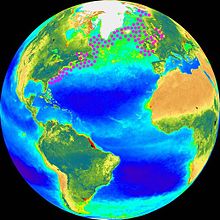Atlantic herring
| Atlantic herring | |
|---|---|
 |
|
| Scientific classification | |
| Kingdom: | Animalia |
| Phylum: | Chordata |
| Class: | Actinopterygii |
| Order: | Clupeiformes |
| Family: | Clupeidae |
| Genus: | Clupea |
| Species: | C. harengus |
| Binomial name | |
|
Clupea harengus Linnaeus, 1758 |
|
 |
|
| Distribution on a NASA SeaWIFS image | |
Atlantic herring (Clupea harengus) is a herring in the family Clupeidae. It is one of the most abundant fish species in the world. Atlantic herrings can be found on both sides of the Atlantic Ocean, congregating in large schools. They can grow up to 45 centimetres (18 in) in length and weigh up to 1.1 kilograms (2.4 lb). They feed on copepods, krill and small fish, while their natural predators are seals, whales, cod and other larger fish.
The Atlantic herring fishery has long been an important part of the economy of New England and the Canadian Maritime provinces. This is because the fish congregate relatively near to the coast in massive schools, notably in the cold waters of the semi-enclosed Gulf of Maine and Gulf of St. Lawrence. North Atlantic herring schools have been measured up to 4 cubic kilometres (0.96 cu mi) in size, containing an estimated 4 billion fish.
Atlantic herring have a body. Gill rakers in their mouths filter incoming water, trapping any zooplankton and phytoplankton.
Atlantic herring are in general fragile. They have large and delicate gill surfaces, and contact with foreign matter can strip away their large scales.
They have retreated from many estuaries worldwide due to excess water pollution although in some estuaries that have been cleaned up, herring have returned. The presence of their larvae indicates cleaner and more–oxygenated waters.
...
Wikipedia

